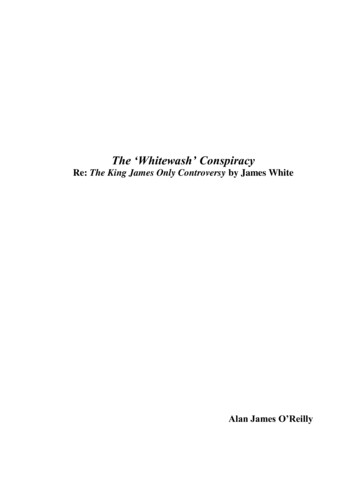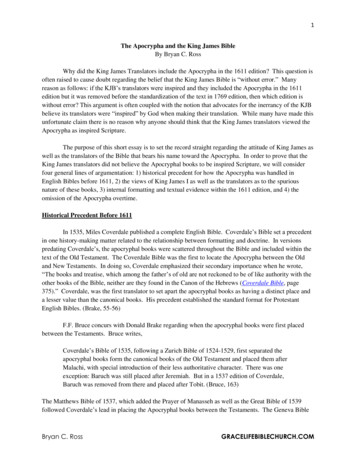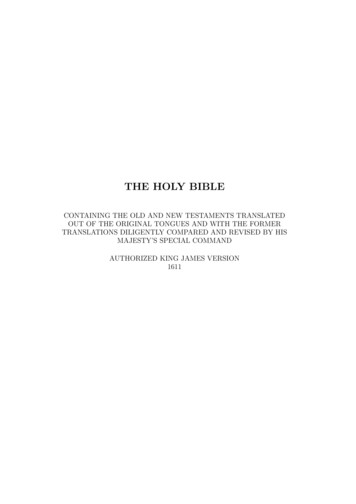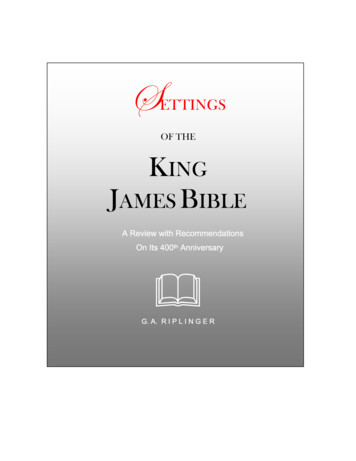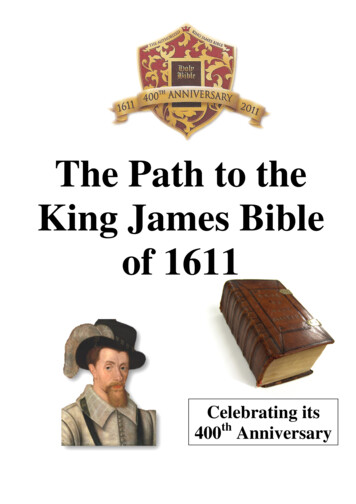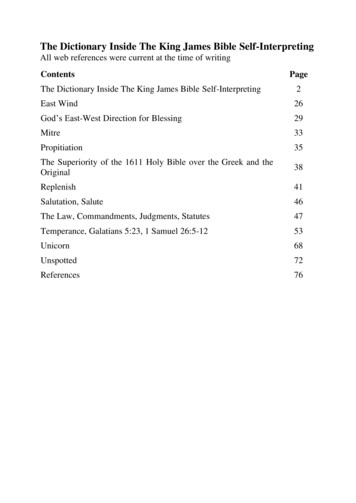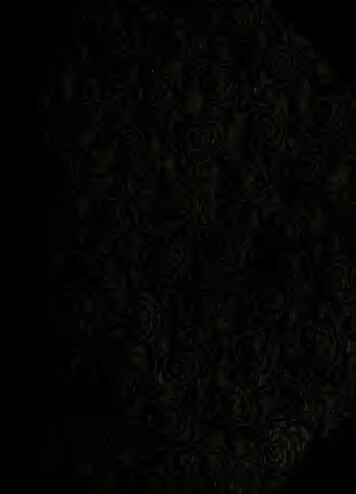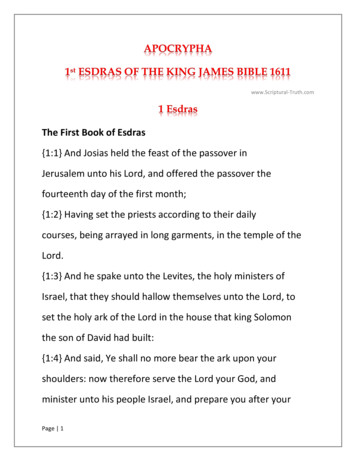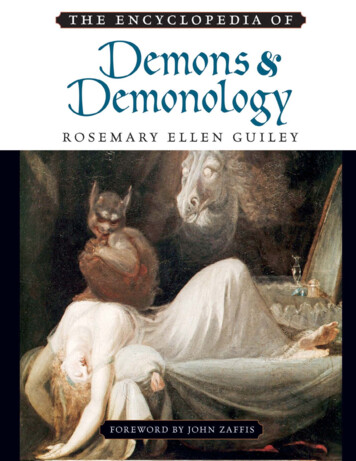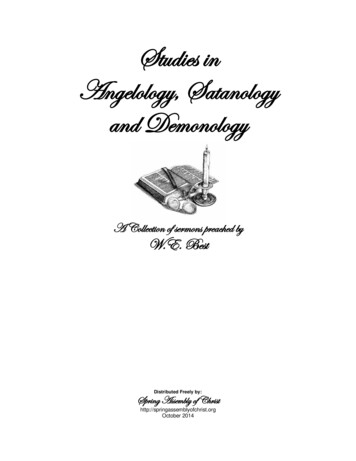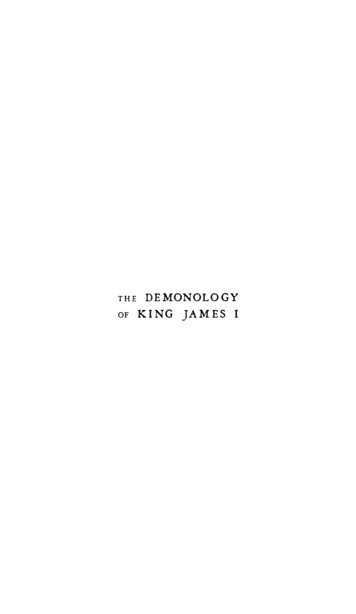
Transcription
THEOFDEMONOLOGYKING JAMES I
DONALDTHEOFTYSONDEMONOLOGYKINGJAMESLlewellyn PublicationsWoodbury, MinnesotaI
The Demonology of King james I: Includes the Original Text of Daemonologie and News fromScotland 2011 by Donald Tyson. All rights reserved. No part of this book may be usedor reproduced in any manner whatsoever, including Internet usage, without writtenpermission from Llewellyn Publications, except in the case of brief quotations embod ied in critical articles and reviews.First EditionFirst Printing, 2011Book design by Donna BurchCover art Dover PublishingCover design by Kevin R. BrownEditing by Tom BilstadFor a complete list of illustration sources, see page 328.Llewellyn is a registered trademark of Llewellyn Worldwide Ltd.Library of Congress Cataloging-in-Publication Data (Pending)ISBN: 978-0-7387-2345-7Llewellyn Worldwide does not participate in, endorse, or have any authority or respon sibility concerning private business transactions between our authors and the public.All mail addressed to the author is forwarded but the publisher cannot, unless specifi cally instructed by the author, give out an address or phone number.Any Internet references contained in this work are current at publication time, but thepublisher cannot guarantee that a specific location will continue to be maintained. Pleaserefer to the publisher's website for links to authors' websites and other sources.Llewellyn PublicationsA Division of Llewellyn Worldwide Ltd.2143 Wooddale DriveWoodbury, MN 55125-2989www.llewellyn.comPrinted in the United States of America
OTHER BOOKS BY DONA L D TYSONThe Messenger(Llewellyn, January 1 990)Ritual Magic: What It Is & How To Do It(Llewellyn, January 199 2)Three Books of Occult Philosophy(Llewellyn, January 1 99 2)Scrying For Beginners(Llewellyn, February 1 997)Enochian Magic for Beginners: The Original System of Angel Magic(Llewellyn, September 2002)Familiar Spirits: A Practical Guide for Witches & Magicians(Llewellyn, January 2004)The Power of the Word: The Secret Code of Creation(Llewellyn, March 2004)1 -2-3 Tarot: Answers In An Instant(Llewellyn, October 2004)Necronomicon: The Wanderings of Alhazred(Llewellyn, December 2004)Alhazred: Author of the Necronomicon(Llewellyn, july 2006)Portable Magic: Tarot Is the Only Tool You Need(Llewellyn, October 2006)Soul Flight: Astral Projection and the Magical Universe(Llewellyn, March 2007)Grimoire of the Necronomicon(Llewellyn, August 2008)Runic Astrology(Llewellyn, July 2009)The Fourth Book of Occult Philosophy(Llewellyn, November 2009)The 13 Gates of the Necronomicon(Llewellyn, July 20 1 0)
CONTENTSIllustration CaptionsxiIntroduction: james and the Witches.D E M ONOLOGYThe Preface: To the ReaderThe First Book.53Chapter I55Chapter II63Chapter I I I67Chapter IV73Chapter V81Chapter V I89Chapter VII99.The Second Book.103Chapter I1 05Chapter II111Chapter III1 15Chapter IV121Chapter V1 27Chapter VI137Chapter VII1 43.The Third BookChapter IChapter II.Chapter IIIChapter IVChapter VChapter VI.1471 49157.1631 691 731 79.45.1
XCONTENTSN E W S FROM SCO TLA N DTo the Reader1 87A True Discourse1 89.Appendix A: Original text of Daemonologie22 1Appendix B: Original text of News From ScotlandAppendix C: Witchcraft Act and Tolbooth Speech ofjames the First301Bibliography307Index313.285
ILLUST R AT I ON C A PTIONSFigure1: Original title page of Daemonologi e, 1597, reproduced inthe Bodley Head reprint. page xvFigureTurning the riddle , or sieve, from the Opera omnia of Cor nelius Agrippa, sixteenth century. It is difficult to judge from theillustration, but it may be that the oracle was given when the sieveslipped down between the blades of the shears, causing it to ro tate slightly. page 77Figure2:Knot magic was believed to be a favorite method ofwitches. A sorcerer stands on a headland and sells two sailorsfavorable winds bound up in three knots. In the background an other ship has been driven into the rocks by adverse winds andhas foundered. From Olaus Magnus' Historia de gentibus septentri onalibus, 1 55 5 . page 78Figure3:A complex magic circle from Reginald Scot's Discoverie ofWitchcraft , 1584. Below it is the descriptive text: "This is the circlefor the master to sit in, and his fellowe or fellowes, at the first call ing, sit backe to backe, when he calleth the spirit; and for the fair ies make this circle with chalke on the ground, as is said before."page 874:Figure 5:Four familiar demons perform tasks for witches. In thecenter, one sweeps out a stable; left, another digs for treasure witha pointed rod; top, a third draws four witches through the cloudsin a wagon; right, the fourth creates a wind to propel a ship. FromOlaus Magnus' Historia de gentibus septentrionalibus, 1 555 . page 93FigureSatan impresses his mark into the forehead of a youngmale witch, from Francesco Maria Guazzo's Compendium Malefi carum, 1 626. page 1 1 36:Figure7: Witches kiss the Devil's buttocks, from Francesco MariaGuazzo's Compendium Maleficarum, 1 626. page 1 1 9XI
XIIILLUSTRATION CAPTIONSFigure8: A winged demon supports a witch flying on a pitchfork,from Ulrich Molitor's Hexen Meysterey, 1 54 5 . Demons are oftendepicted riding with witches through the air on their brooms orstaffs. The intention is to show that the Devil provides the occultpower that propels the witch through the air, not the witch her self. page 1 25Figure 9:A female witch raises a storm to sink a ship by pouring liq uid from a small kettle while brandishing a knife. Note the waningcrescent of the Moon. In the lower part of the panel, a male witchwith a skull-headed staff sits and bewitches livestock. From OlausMagnus' Historia de gentibus septentrionalibus, 1 5 5 5 . page 1 34FigureA werewolf attacks a traveler just outside the gate of atown . A woodcut from johann Geiler von Kaysersberg's DieEmeis, 1 5 1 7. page 1 5510:Figure11: An incubus seduces a witch in a secluded meeting place .From Ulrich Molitor's Von den Unholden und Hexen. page 1 67Figure12:Figure13:Figure14:A knight approaches in supplication the queen and kingof fairy and their court, who wait to greet him beneath a fairyknoll. page 1 77Public execution by burning of three witches in Derne burg, Germany, from a 1 55 5 broadsheet. At the right we see twoof the witches setting fire to a building, while a man lies appar ently dead outside the door. The background shows an executionby beheading with a sword, and three learned and prosperousmen who watch the burning of the witches and comment uponit. At the top, a demon descends to catch the soul as it leaves themouth of one of the dying witches. Center, two men tend thefire . When witches were burned alive, it sometimes happenedthat their bindings burned off before they died, and they had to becast back into the fire when they tried to escape. page 1 84Original title page from a 1 592 edition of News From Scot land, reproduced in the 1 924 Bodley Head reprint. page 1 85
ILLUSTRATION CAPTIONSXIIIFigure 15: This is one of two woodcuts in the Bodley Head reprintof an early edition of News From Scotland that was not designedspecifically for the work. It may have been included to suggesthow the North Berwick witches were chastised with a rod beforeKing james and the chief magistrate . page 1 9 1Figure16: The initial o f two woodcuts included i n the first editionof News From Scotland , designed to illustrate the material in thetext. In the Bodley Head reprint of a slightly different 1 592 edi tion of the tract, this woodcut is reproduced twice-just after thetitle page, and again in the body of the work. Clockwise from theleft, it depicts the Devil of the North Berwick witches preachingfrom an outdoor pulpit to an audience of female witches whilejohn Pian sits at a table recording his words with pen and paper; aship foundering in a storm at sea; four female witches brewing apotion in an iron kettle with a long-handled ladle, a peddler lyingupon his side; and finally, the same peddler lying in a similar pos ture in a wine cellar in Bordeaux, France . page 1 97FigureThe second of two woodcuts made specifically for thefirst edition of News From Scotland depicts the activities of johnFian . Clockwise from the upper right, we see Pian attempting toremove the bewitchment from an amorous cow; Pian riding onan illuminated black horse behind a man clothed in a black capeand hat; the church at North Berwick; and a gallows. The cowrefers to the story attributed to Fian that was borrowed from theGolden Ass of Appuleius. As for the illuminated horse, part of thecharges read against Pian at his trial were that when he was rid ing past Tranent on horseback with another man in the middleof the night, he "by his devilish craft, raised up four candles uponthe horse's two legs, and another candle upon the staff which theman had in his hand; and gave such light, as if it had been day light; like as, the said candles returned with the said man, uponhis homecoming; and caused him to fall dead at his entry withinthe house . " The gallows, which appears to have been inserted1 7:
XIVI LLUSTRATION CAPTIONSinto the woodcut, shows that the artist was an Englishman, sincewitches were burned in Scotland, not hanged. page 200Figure18: This is the second of two woodcuts in the 1 924 BodleyHead reprint of a 1 592 edition of News From Scotland that was notcreated specifically for the tract. It is located at the end of the work,after the text, and appears to show a man being led to prison be tween a jailor with keys hanging at his waist and a nun who graspsthe man by the ear. page 203Figure 19: Wedges are driven into the boots to shatter the bones inthe shins and ankles of the unfortunate man being tortured. Atthe right, a standing inquisitor asks questions while one seated ata desk records the man's confession. Although this is not a partic ularly good illustration of the boots themselves, it does show thetype that were used in Scotland during the North Berwick affair.A woodcut from the late sixteenth century. page 2 1 8FigureTitle page to the first edition of News From Scotland, pub lished in 1 592. page 28420:
DAEMONOLO·fjiE IS( FO MBofa 'Dialogue Diuidcd into threcBookes.EDINIVJlOBPrinted by bert Wa/Je grttlle.J.Print« to the KingsMajdlic. An.1sn CIRII Pri'uiltgillllgil.Figure1
DEMONOLOGY,In the Formof a Dialogue,Divided into Three Books.EdinburghPrinted by Robert WaldegravePrinter to the King's Majesty, anna 1 597.With Royal Privlege.
INTRODUCTIONjames and the WitchesT H E ONCE A N D FUTURE KI N GJames Stuart was born on June 19, 1 566, at Edinburgh, from theunion of Mary, Queen of Scots, with her second husband, HenryStewart Lord Darnley. When his mother was forced to abdicate herthrone by Queen Elizabeth, James was proclaimed King James theSixth of Scotland on July 24, 1 567. For the first twelve years of his lifehe was not permitted to participate in state affairs, but was kept forhis own security in Sterling Castle, safe from the constantly bickeringScottish factions.Physically he was weak and sickly, a misfortune of health thatplayed a significant part in his tendency in later life to achieve hispurposes by manipulation and deceit rather than the bold exerciseof power. For the first six or seven years of his life he was unableto stand up or walk without aid. As a young man he developed alove for horseback riding, but it was necessary that he be tied onto his horse due to the weakness in his legs, and once when he fellinto a body of water while out riding he nearly drowned because hewas unable to help himself. Throughout his life he preferred to walkleaning on the shoulder of an attendant.Weakness of body was in part compensated for by keenness ofintellect. When Sir Henry Killigrew saw the boy in 1 574 he was im pressed by the skill of eight -year-old James in translating Latin and
2INTRODUCTIONFrench texts. From an early age he was trained by his guardians inthe Protestant faith, and developed an aversion for Catholicism, al though this did not prevent him from sending a letter to the pope in1 584, hinting that he might be persuaded to change his faith if it for warded his political goals. James was always ready to imply friend ship and favor, provided there was no actual necessity of ever givingthem.There seems little doubt that James was a coward. He foughtagainst this tendency throughout his life, but it was his nature andhe could never overcome it. In 1 5 82 he was kidnapped by a factionof Scottish nobles during the Raid of Ruthven. Although he wasthen old enough to shave, he was so terrified of his captors that hecried like a child. Sir Thomas Lyon, one of the men keeping himhostage, gruffly told the young king it were better 'bairns [children]should greet [cry] than bearded men." James parted from his cap tors in 1 5 83 and began to rule his kingdom, but always remainedtimid. The Marquis de Fontenay, French ambassador to the Scottishcourt during the early part of his reign, spoke of James as cowed bythe violence around him. When in 1 5 87 his mother was executed byorder of Elizabeth, he made little effort to prevent it.His personal appearance and manners were not attractive . Hehad a tendency to bluster and make promises he had no intentionof ever fulfilling. He talked too much in a very thick Scottish ac cent, and was pedantic and put on airs of scholarship that he did notmerit. In dress he was slovenly and unclean. His physical caressesand frequent gifts to male favorites in his court gave rise to gossipthat he was homosexual. All these tendencies were strongly despisedby the English people when he ascended to the throne of England in1 603 at the death of Elizabeth, but they swallowed their distaste andwelcomed him in a practical spirit, as the only alternative to bittercivil war.In 1 589 James married Anne, second daughter of Frederick theSecond, king of Denmark. This union between the Prot
OTHER BOOKS BY DONALD TYSON The Messenger (Llewellyn, January 1990) Ritual Magic: What It Is & How To Do It (Llewellyn, January 199 2) Three Books of Occult Philosophy (Llewellyn, January 199 2) Scrying For Beginners (Llewellyn, February 1997) Enoch ian Magic fo r Beginners: The Original System of Angel Magic (Llewellyn, September 2002)
